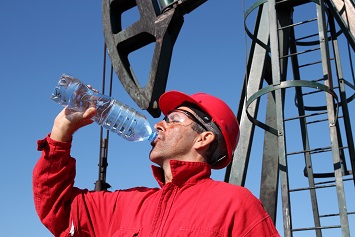While forces affecting the workplace change rapidly—an aging workforce, new work arrangements, and state adoption of medical and recreational marijuana laws—regulatory changes move at a slower pace.
The National Institute for Occupational Safety and Health (NIOSH) usually is at the forefront of workplace safety and health developments. NIOSH Director John Howard, MD, this fall unveiled a new “Future of Work” initiative.
The initiative at several units of NIOSH is looking at issues such as:
- The aging workforce;
- Shifting employment relationships like contingent or “gig” employment; and
- Uncertainty about how best to manage new technologies like artificial intelligence, robotics, and 3D printing entering the workplace.
NIOSH researchers are looking at issues that include particulates and volatile organic compounds emitted by 3D printers, rapid growth in fields like health care, and new occupations like solar photovoltaic installer and wind turbine service technician.
OSHA Rulemakings
Rulemaking at OSHA has slowed but not stopped during the Trump administration. The agency has made a few attempts at deregulation, mostly to address a last-minute Obama administration rulemaking for beryllium exposures.
After an effective date freeze and delayed enforcement of the revised beryllium standards, OSHA began enforcing provisions of the general industry standard on March 11, with enforcement of the engineering controls in the general industry standard starting March 10, 2020.
OSHA decided to implement ancillary provisions of the construction and shipyard standards it had proposed revoking, concluding that the provisions were not duplicated in other construction and shipyard standards.
However, the agency has not finished its work on beryllium regulation. It proposed amending definitions used in the construction and shipyards standards and removing certain provisions for hygiene areas and practices. It also would revise provisions for methods of compliance, respiratory protection, personal protective equipment (PPE), housekeeping, medical surveillance, communication of hazards, and recordkeeping.
While the agency abandoned an Obama-era proposal to remove a single word from the control of hazardous energy, or lockout/tagout, standard that many employers feared would broaden the scope of the standard, OSHA did decide to revisit the standard.
The agency asked for public comment on two changes to the standard it is considering:
- Allowing the use of control circuit-type devices while equipment or machines are being maintained or serviced; and
- Amending the general industry standard to address hazardous energy control for new robotics technologies.
OSHA has provided no update on any further rulemaking action on lockout/tagout.
A push for more workplace safety and health regulation likely will come from outside the agency. The American Society of Safety Professionals (ASSP) advocated for legislation extending OSHA’s authority to federal, state, and local government employment and another bill requiring the agency to establish a federal workplace violence prevention standard.
Six- or Seven-Figure OSHA Penalties
While some activists had predicted a Trump administration Labor Department would gut OSHA enforcement, the agency has continued to seek six-figure and even seven-figure penalties.
OSHA cited a Maine roofing contractor for 17 egregious willful, repeat, and serious workplace safety violations, seeking nearly $1.8 million in penalties.
The agency has proposed high-dollar penalties in several other cases:
- $724,380 in penalties for a Moraine, Ohio, glass manufacturer;
- $687,619 in penalties for two construction contractors at the Port of Wilmington, Delaware;
- $413,370 in penalties for a Lebanon, Missouri, barrel maker;
- $287,212 in penalties for a Hauppauge, New York, fabric-care product manufacturer; and
- $236,089 in penalties for a Pleasantville, New Jersey, produce wholesaler.
Employers can expect to see more six-figure penalties under OSHA’s new enforcement weighting system that emphasizes inspections for four construction industry hazards.
The agency assigns an Enforcement Unit (EU) measure for various inspections. OSHA heavily weighted inspections during the Obama administration for ergonomics, process safety management, and workplace violence hazards. The new enforcement weighting system de-emphasizes inspections for ergonomics and workplace violence but prioritizes inspections for:
- Caught-in or -between hazards,
- Electrical hazards,
- Fall hazards, and
- Struck-by hazards.
Citations for fall hazards resulted in some of OSHA’s largest penalties this year. Agency compliance safety and health officers (CSHOs) now have greater incentive to pursue these inspections.
Aging Workforce
Employment of workers aged 65 or older has grown by 117% in a span of 20 years, according to the Labor Department’s Bureau of Labor Statistics (BLS), and one in four American workers will be over the age of 55 by 2020.
While older workers are less likely to become injured, their injuries are more severe and sometimes fatal.
The BLS has found a significant correlation between worker age and both the number and the rate of fatal workplace injuries.
The highest fatal injury rate now is among workers aged 65 years and over. They accounted for 775 deaths in 2017 at a rate of 10.3 workers per 100,000. Workers aged 65 or over accounted for 15% of fatally injured workers—an all-time high in the 26-year history of the BLS’s Census of Fatal Occupational Injuries.
Heat Stress
Each summer is hotter than the last. National Air and Space Administration data show 18 of the past 19 years have been the hottest on record.
Expect OSHA to cite more employers for violations of the Occupational Safety and Health Act’s General Duty Clause. And enforcement cases are not limited to Sun Belt states. OSHA recently cited a utility-pole service provider in the heat-related death of a worker at a site in Inman, Nebraska.
Expect legislators and activists to continue pushing for OSHA to adopt a heat stress standard. Public Citizen and 111 other groups urged the secretary of Labor and head of OSHA to establish a federal standard for protecting workers from heat stress.
Rep. Judy Chu (D-CA) and 27 cosponsors introduced a bill in the House of Representatives this summer requiring OSHA to issue a proposed heat stress standard within 2 years and a final regulation within 42 months. The federal standard would have to be at least as effective as the most stringent state standard and include provisions for hydration and paid rest breaks, medical surveillance, and recordkeeping.
Fatigue
The National Safety Council (NSC) estimates a typical employer with 1,000 employees can expect to lose more than $1 million a year due to fatigue:
- $272,000 due to absenteeism,
- $776,000 due to “presenteeism” (employees who are at work but not fully functional), and
- $536,000 in healthcare costs.
The NSC and researchers at Brigham and Women’s Hospital in Boston developed the “NSC Fatigue Cost Calculator” to estimate the cost of sleep deficiency for individual businesses.
Fatigue has been cited as a factor in some of the biggest industrial accidents in history, including the 2005 BP Texas City oil refinery explosion, 2009 Colgan Air Crash, and 2010 Deepwater Horizon oil spill.
Fatigue also is a leading cause in motor vehicle crashes, and even nonfatal injuries can be serious. While the median number of days away from work for most workplace injuries is 8 days, the median for roadway incidents is 10.
The ASSP began studying the use of body sensors to help detect signs of fatigue and alert supervisors to the need for intervention. Researchers found the common root causes of fatigue were lack of sleep, shift schedule, and work stress. Wearable sensors monitoring body movements can detect the starting point of fatigue. Wearable sensors can detect physical fatigue in a number of different occupational settings, and researchers suggested manufacturing-sector employers could benefit from investing in data-driven assessments to prevent occupational injury.
However, employees and labor unions could challenge the adoption of body sensor technology.
The American Industrial Hygiene Association (AIHA) supports collecting and analyzing large amounts of data from body sensors to better protect workers. The group called for significant increases in funding for research and development of sensors to detect workers’ exposures to biological, chemical, physical, and radiological hazards.
Cannabis
Safety problems posed by worker impairment will plague employers as more states pass medical and recreational cannabis/marijuana laws.
Illinois became the 11th state to legalize recreational use of marijuana. Now, 34 states and Washington, D.C., have legalized either medical or recreational marijuana use. Illinois’s law goes into effect January 1. Several bills to decriminalize, reclassify, or legalize marijuana also have been introduced in the U.S. Congress.
Employers have good reason for concern. Positive drug test results for transportation and warehousing workers increased by double digits between 2015 and 2017, according to laboratory testing firm Quest Diagnostics.
Six industry sectors saw year-over-year increases in positive results for marijuana of least 20%—transportation and warehousing, other services, construction, wholesale trade, manufacturing, and accommodation and food services.
There is no test yet that measures the degree of impairment caused by various levels of tetrahydrocannabinol (THC).
While the impacts of various blood alcohol levels are well understood, the science behind marijuana impairment is not as well defined. In the absence of any reliable impairment testing, the AIHA and NSC both have advocated for zero-tolerance policies for workers in safety-sensitive positions.
The NSC has pointed out that an increase in motor vehicle accidents involving THC occurs in states after implementation of medical or recreational marijuana laws. The American College of Occupational and Environmental Medicine (ACOEM) also released a policy statement cautioning that marijuana interferes with safety performance in the workplace.



